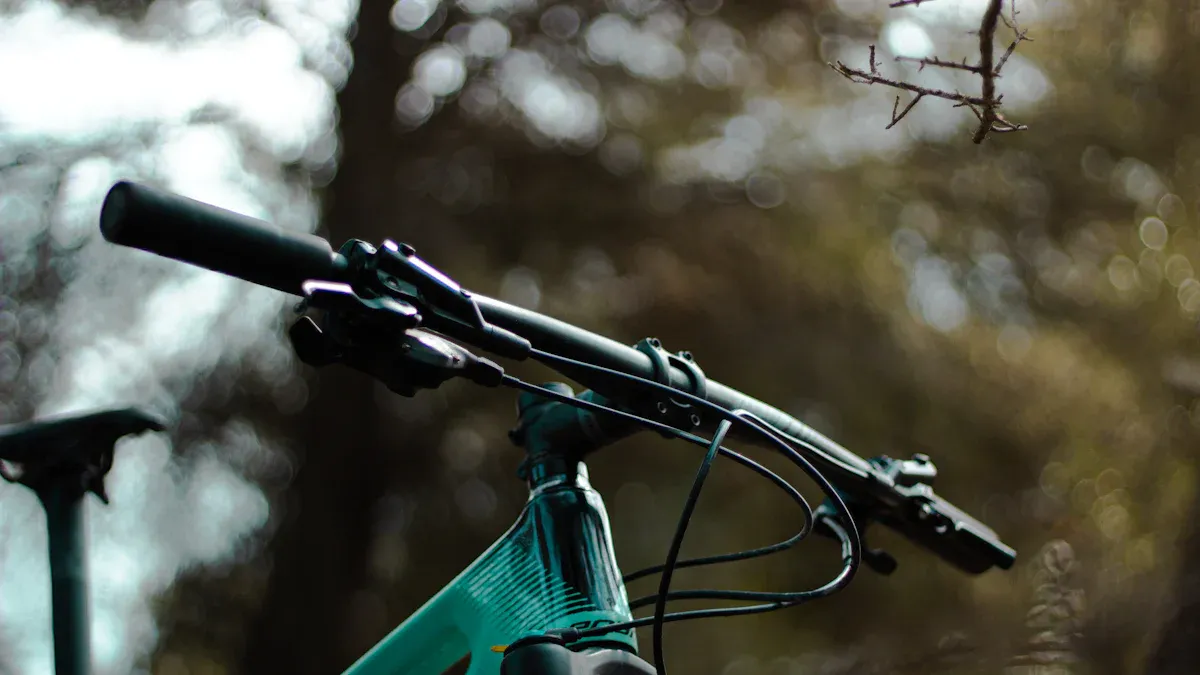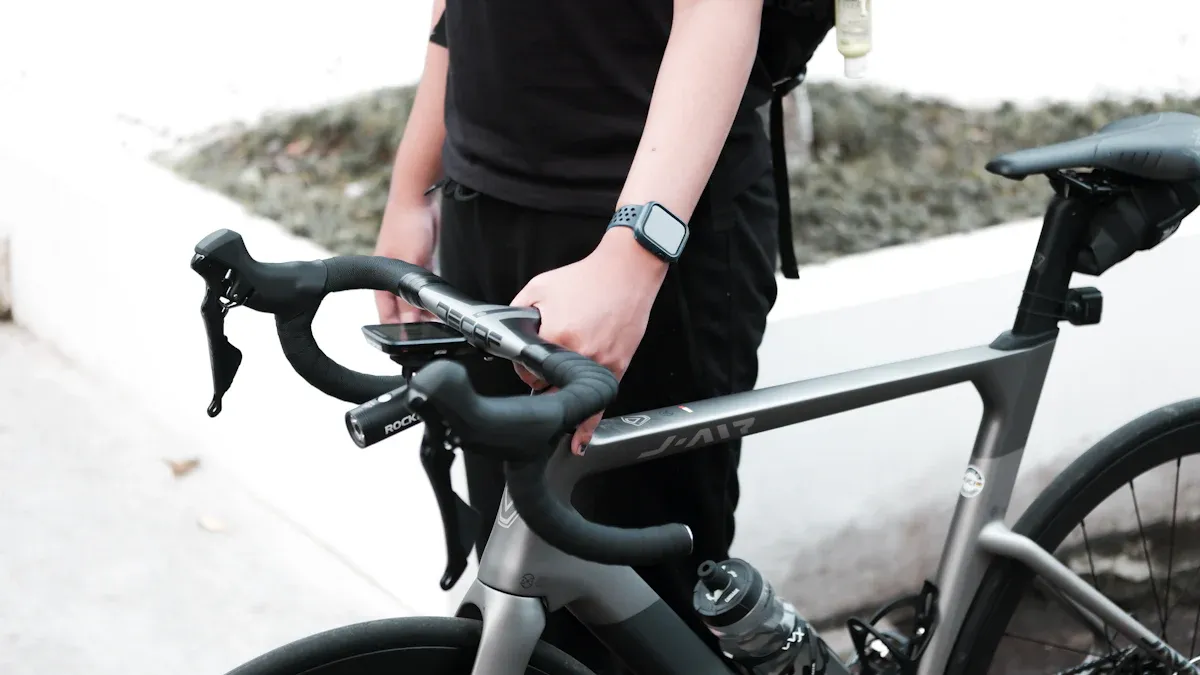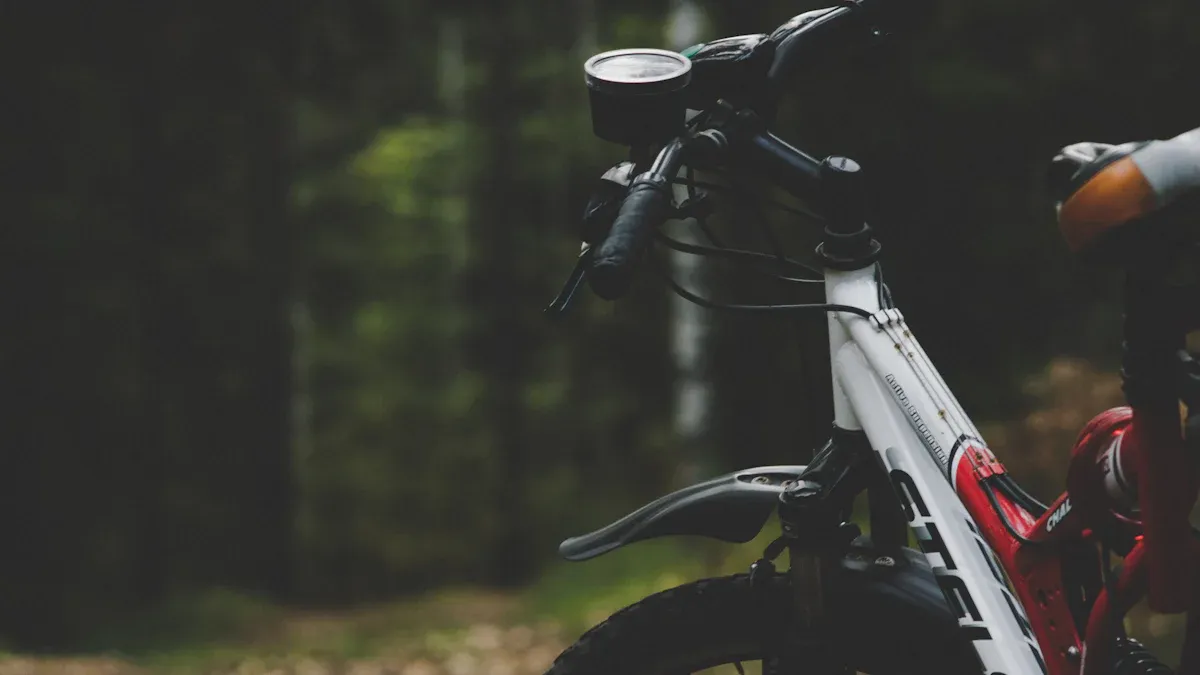
Choosing the right frame enduro bike is very important. It affects how well you perform and how comfortable you feel on the trails. A bike that fits you well can make your ride much better. For example, a bike’s vertical stiffness changes how comfy you are on long rides. Less stiffness usually means more comfort, especially on bumpy paths.
When you pick the right bike, remember that frame geometry matters too. It can change your posture and comfort level. Steeper seat tube angles can help you ride longer and harder. With these points in mind, you will be ready to make a smart choice.
Key Takeaways
Figure out your riding style—aggressive or casual—to pick the right bike features.
Choose frame material carefully; carbon is light, while aluminum is strong.
Know frame geometry; it affects how the bike handles and feels on trails.
Measure yourself correctly to find the right bike size for better control and comfort.
Always test ride before you buy; it helps you see how the bike works and fits.
Riding Style
When you choose a frame enduro bike, your riding style is very important. Different styles need different frame features. Let’s look at two main types: aggressive riding and casual riding.
Aggressive Riding
If you ride aggressively, you handle steep hills and tough trails easily. Your bike must manage rough ground and soak up bumps well. Here are some important features for aggressive riding:
Suspension Travel: Find bikes with 150-180 mm of travel in both the front and back. This extra travel helps you go over rocky paths and absorb shocks.
Headtube Angle: A slacker headtube angle gives you better stability at high speeds and on descents. This helps you stay in control on hard trails.
Fork Size: Pick a fork with at least 36mm, but 38mm is better. A stronger fork can meet the needs of aggressive riding.
Here’s a quick look at frame needs for aggressive and casual riding:
Feature | Aggressive Enduro Riding | Casual Enduro Riding |
|---|---|---|
Suspension Travel | 150-180 mm front and rear | 130-160 mm front, up to 150 mm rear |
Headtube Angle | Slacker than trail bikes | Slightly steeper than downhill bikes |
Fork Size | Minimum 36mm, up to 38mm | Minimum 34mm, up to 36mm |
Pro enduro riders often pick full-suspension frames for their aggressive style. These bikes give better control and comfort on tough ground. The rear suspension keeps the wheels on the ground, which is key for going down steep hills and tricky spots. This choice shows their need for stability and confidence in hard conditions.
Casual Riding
If you like a more relaxed style, your frame needs will be different. Casual riders enjoy smoother trails and easier terrain. Here’s what to think about:
Suspension Travel: You may find that 130-160 mm of travel is enough for you. This range gives a good mix of comfort and performance.
Headtube Angle: A slightly steeper headtube angle can help you climb better, making it easier to go up hills.
Fork Size: A fork size of 34mm to 36mm is usually good for casual riding, giving enough support without being too heavy.
Aggressive riders need frames built for strength and stability, especially on tough and rocky ground. On the other hand, casual riders can choose lighter frames that are more agile on smooth trails.
In the end, knowing your riding style will help you pick the right frame enduro bike that fits your needs and improves your overall fun on the trails.
Frame Material

When you pick your frame enduro bike, the material is very important. It affects how your bike works and feels on the trails. Each material has its own good and bad points. Let’s look at the most common choices: aluminum, carbon, and steel.
Aluminum
Aluminum is a popular choice for many enduro mountain bikes. It is light and can handle crashes well. Here are some good and bad points to think about:
Pros:
Lightweight, which helps you climb hills easier.
Corrosion-resistant, so you don’t have to worry about rust.
Usually cheaper than carbon fiber.
Cons:
Aluminum frames can crack over time, especially after hard hits.
They last shorter than steel and carbon, meaning they might not hold up as long with heavy use.
In terms of weight, aluminum frames are lighter than steel but heavier than carbon. This makes them a good middle option for riders who want a mix of performance and cost.
Carbon
Carbon fiber frames are known for being very strong and light. They are often chosen by serious racers and aggressive riders. Here’s what you should know:
Pros:
Very lightweight, allowing for faster climbs and easier handling.
Great fatigue resistance, meaning they can handle rough rides without wearing out fast.
They give a comfortable ride, absorbing bumps from the trail.
Cons:
Carbon can break from impacts, which makes repairs hard and often expensive.
They are usually more costly than aluminum and steel frames.
Some riders worry about hidden damage, as cracks can happen inside without showing.
Here’s a quick comparison of the frame materials:
Frame Material | Key Properties | Pros | Cons |
|---|---|---|---|
Steel | Very strong, absorbs shocks, repairable | Durable, easy to fix | Heavy, can rust |
Aluminum | Lightweight, good crash resistance | Won’t rust, recyclable | Shorter fatigue life, harsh ride |
Carbon Fiber | Excellent fatigue resistance, lightweight | Very light, resists fatigue | Breaks from impacts, hard to fix |
Steel
Steel frames are less common in modern enduro bikes but still have their place. They are known for being durable and absorbing shocks. Here’s a closer look:
Pros:
Very durable and can last for years with care.
Easy to repair if damaged, making them a good long-term choice.
They can bend instead of breaking, which is great for rough trails.
Cons:
Heavier than both aluminum and carbon, which can affect climbing.
Can rust if not taken care of properly.
In terms of maintenance, steel needs regular checks to stop rust, while aluminum needs less care but can be harder to fix if damaged. Carbon fiber frames are low maintenance but can be tough to repair if they get damaged.
Choosing the right frame material depends on your riding style and budget. If you want something light and high-performing, carbon might be best. But if you want something strong and easy to maintain, aluminum or steel could be better choices.
Frame Geometry

When you choose your frame enduro bike, geometry is very important. It affects how well your bike handles and how comfortable it is. Knowing how different geometry factors change your ride can help you decide better.
Handling
The way your bike handles depends on several geometry factors. Here’s a quick look at how these parts work together:
Geometry Factor | Impact on Handling Characteristics |
|---|---|
Longer Reach | Makes the bike more stable at high speeds and downhill, but can make tight turns harder. |
Shorter Reach | Helps with tight turns in tricky areas, but may feel less stable when going fast. |
Steeper Head Angle | Gives quicker steering and better climbing, good for sharp turns. |
Slacker Head Angle | Provides more stability at high speeds, great for steep descents and rough trails. |
Longer Wheelbase | Increases stability at high speeds and makes the ride smoother over bumps. |
Shorter Wheelbase | Improves agility in tight turns, making it easier to handle tricky sections. |
You’ll see that reach works with the top tube length, head angle, and stack height. These factors together decide how your bike handles. A slacker head angle gives you more stability on steep trails, while a steeper angle helps you turn easily in tight spots.
Comfort
Comfort is another key part affected by frame geometry. Important measurements that change your comfort include reach, stack, head angle, and seat tube angle.
Reach changes how the bike feels when you stand, affecting your control and balance.
Stack decides how high the cockpit is, which influences your riding position.
Head Angle affects climbing and going downhill, changing how the bike reacts to your movements.
Seat Tube Angle impacts weight distribution, which can help you pedal better.
Modern enduro mountain bikes have changed a lot in the last ten years. For example, today’s bikes have longer reaches (about 450-460 mm) compared to 30-50 mm shorter reaches from a decade ago. Also, head angles are now slacker, averaging around 63-65 degrees, which improves stability on descents. These updates make handling and comfort better, making your rides more fun.
Size Matters
Choosing the right size for your frame enduro bike is very important. A bike that fits you well makes your rides better and helps you perform better. Let’s look at how to measure for the right size and what to think about for a good fit.
Measuring Techniques
To find the best frame size, you can use some easy methods:
Take a tape measure and a hardcover book. Stand against a wall with your bike shoes on and straddle the book spine. Mark where the book touches the wall. Then measure from that mark to the floor to get your inseam.
For more accurate measurements, you can use a laser level and a digital angle finder. This helps you measure the saddle clamp to bottom bracket (BB) size correctly. Put the rear wheel against a wall and measure from the BB center to the wall. Then measure from the saddle clamp center to the wall. Subtract the two numbers to find the right seat tube angle.
Remember that mountain bikes come in standard sizes (S, M, L) based on your height. Check the manufacturer’s size chart for height ranges. If you are between sizes, choose the smaller size for a better fit.
Fit Considerations
Getting the right fit is more than just frame size. Here are some important things to think about:
Frame Size: Bigger bikes can feel smaller, but smaller bikes are harder to make feel bigger.
Adjustments: You can change the saddle position and stem length to make handling and comfort better.
Rider Characteristics: Your body shape and flexibility are important for finding the right frame size.
Riding a bike that is too small can cause discomfort, knee pain, and make climbing harder. On the other hand, a bike that is too big can make you reach too far, making it hard to steer. This can increase the chance of getting hurt. Proper sizing is key for keeping stability and control, especially when riding aggressively.
Here’s a quick look at how different frame sizes affect maneuverability and control:
Factor | Effect on Maneuverability and Control |
|---|---|
Wheelbase | A longer wheelbase gives stability, reducing oversteer and making long rides more comfortable. A shorter wheelbase makes the bike easier to steer. |
Chainstay Length | Shorter chainstays make the bike more responsive and agile, which is great for tricky riding. Longer chainstays help with stability and pedaling, good for fast descents. |
Head Tube Angle | A steeper head angle makes the bike feel more responsive, while a slacker angle gives stability at high speeds, affecting how it handles on tough trails. |
Finding the right fit is very important for enjoying your rides. Take your time measuring and thinking about your choices. You will be happy you did!
Test Ride
When you choose your frame enduro bike, nothing is better than a test ride. This step is very important to find the right fit and feel for your riding style. You wouldn’t buy a car without trying it out, right? The same is true for bikes!
Importance of Test Riding
Test riding helps you see how a bike works in real life. It’s your chance to feel how the bike handles, stays stable, and is comfortable. Surveys show that 69% of riders think test rides are a big part of their choices. They want to see how the bike reacts to their movements and how it feels on different surfaces.
What to Look For
While you test ride, watch for some key things. Here’s a helpful table to remember:
Factor | Description |
|---|---|
Stability | Check how stable the bike is at high speeds and on tough trails. |
Handling | Notice how well the bike turns and its balance, making it easier for you to ride. |
Suspension | Look at how well the bike handles bumps, comfort, and grip from the suspension. |
Fun Factor | Think about how much fun you have while riding, even on bikes that feel unsteady. |
Value for Money | Compare how well the bike performs on the trail to its price and quality of parts. |
As you ride, notice how the bike feels. Does it make you feel safe on steep paths? Can you turn easily in tight spots? These things are very important for aggressive trail riding.
Also, test rides let you try the kind of riding you want to do. You can test different models, including full-suspension bikes, even if you first thought about a hardtail. This hands-on experience helps you learn about the bike’s features, size, and shape.
Remember, just like trying out a car is important, test riding a bike is key. It helps you understand the bike better and make a smart choice.
Choosing the right frame enduro bike is crucial for your riding experience. Remember these key tips:
Riding Style: Know whether you ride aggressively or casually to find the right features.
Frame Material: Consider options like carbon for lightness or aluminum for durability.
Frame Geometry: Look for designs that enhance handling and comfort.
Size Matters: Take the time to measure yourself for the best fit.
Test Ride: Always try before you buy to see how it feels on the trails.
Taking your time with these choices can lead to better comfort and performance, making your rides more enjoyable. So, don’t rush—find the perfect frame that suits your needs!
FAQ
What is the best frame material for an enduro bike?
The best frame material depends on your needs. Carbon is lightweight and strong, while aluminum offers durability at a lower cost. Steel is durable but heavier. Choose based on your riding style and budget.
How do I know what size frame I need?
To find your frame size, measure your inseam and check the manufacturer’s size chart. If you’re between sizes, opt for the smaller size for better control and comfort.
Can I upgrade my bike’s components later?
Yes! You can upgrade components like the suspension, wheels, and handlebars. This allows you to customize your bike as your skills and preferences evolve.
How often should I maintain my enduro bike?
Regular maintenance is key. Check your bike before each ride, clean it after muddy trails, and perform a full tune-up every few months. This keeps your bike in top shape.
Is it necessary to test ride a bike before buying?
Absolutely! Test riding helps you feel how the bike handles and fits. It’s the best way to ensure you choose a bike that matches your riding style and comfort needs.
See Also
Key Factors to Evaluate When Selecting an E-Mountain Bike Frame
Essential Tips for Selecting the Ideal Bike Frame
Practical Advice for Picking a Durable Cargo Bike Frame
Guidelines for Finding the Best Step Through Bike Frame
Selecting the Right Bike Frame for Optimal Comfort and Performance
